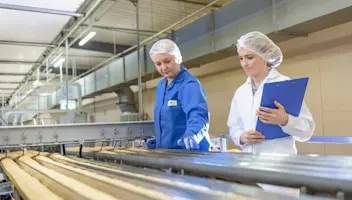Jenny Peng’s Intelligence, Passion and Optimism Drives her Success as Aptean’s CTO
Jenny Peng’s Intelligence, Passion and Optimism Drives her Success as Aptean’s CTO
Jenny Peng’s Intelligence, Passion and Optimism Drives her Success as Aptean’s CTO
6 März 2020
Aptean Staff Writer
It was a true and genuine pleasure to be in conversation with Aptean’s CTO, Jenny Peng. She’s passionate and excited, and her enthusiasm is contagious. Her job is a balancing act of sorts—between her teams, her projects and her implementations, Peng is pretty busy. And she couldn’t be more excited about it.
What brought you to Aptean initially? And what keeps you here? I joined Aptean as a result of Vista’s acquisition of CDC Software many years ago. Initially, I was the vice president of engineering. Within my first year as a member of this new portfolio, I was nominated for the Vista’s High Potential Leadership Program where I learned to have an enterprise view. Not only was that an amazing growth opportunity for me personally, but being a part of a portfolio that supports my interests and my professional growth is really valuable to me.
As far as what keeps me here, it’s the people. Not only is everyone here smart, driven and friendly, but they share my passion to evolve, learn and grow the business. Also, the spirit of innovation is extremely valuable to me. I speak about this not only from a product and technology perspective, but we’re a very innovative company. We’re not afraid to challenge the status quo, and to me, that’s the real spirit of innovation.
As Aptean's CTO, what are your key responsibilities and initiatives? As CTO, I am responsible for many of the technology-related functions and teams within Aptean. I manage global product development, common technology & innovation, cloud operations, security & compliance and information technology functions.
My team and I work hard to drive customer success by continuously enhancing our products to align with the industries we serve. Our products are purpose-built and specific to certain niches and micro-sub-verticals within a certain industry where we are speaking directly to their challenges. Innovating on top of that can be challenging, but we’re able to do that because of our operating platforms and willingness to innovate.
How do you stay focused on the present while also attending to the rapidly changing trends of the future? To balance the present and the future, you need to start with good time management. It’s so valuable to set aside time to focus on the present, drive results and get things done, as well as deliberately carving out time to focus on learning how to effectively invest in the future.
There are two methods I use to help me think structurally.
The Important-Urgent Matrix, which was popularized by Stephen Covey’s The Seven Habits of Highly Effective People, helps me to classify inititiaves and tasks between important and not important, then urgent and not urgent. This 2x2 matrix results in four quadrants: tasks that are important and urgent, important but not urgent, not important but urgent, and lastly not important and not urgent. Looking at my tasks in this manner helps me to be most effective with my time.
The Pomodoro Technique, developed by Francesco Cirillo, chunks your time. The idea is simple: you work hard with minimized distractions for 25 minutes and then take a break. The philosophy is also simple: frequent breaks improve mental agility, allowing you to feel refreshed, recharged and ready to tackle new tasks. I use this technique with projects that are audacious and often very time-consuming. It keeps me from becoming overwhelmed or daunted by a big project so I can pace myself.
How do you keep yourself up-to-date with the latest technology? I’m a firm believer that innovation is driven by practitioners who are closest to the technology, and I strive to cultivate and encourage that culture. Once I have the time carved out to focus on learning, specifically on all the changing trends and technologies, here’s how I keep myself up-to-date:
The app to find relevant technology news stories targeted to my preferences.
I enjoy reading very much. Books about leadership, technology, management, and macro trends in technology and society. Right now I am reading by Liz Wiseman and by David Allen.
When I can, I find time to meet with a small number of targeted vendors who I believe are defining or leading in a particular category. This allows me to audit my current technology portfolio against the marketplace and proactively plan for upgrades or changes.
There’s also no substitute for hands-on technology usage. Although I no longer code each day, I still prioritize learning new technology or programming language every year. This year I’m focused on learning more about Azure platform services and better understand the various tools available in the cloud environment.
I ask my team not to be shy and tell me what I should be learning.
Which technology trends are you most excited about and why? I think the thing that excites me the most is the evolution of smart manufacturing and Industry 4.0. Today companies in our targeted industries are moving towards a new level of interconnected and intelligent systems that incorporate sensors, robotics, big data and machine learning.
The factory of the future will be smart; with the way technology is advancing, that can’t help but be true. The factory won’t only be automated, the machines will be in communication with each other. Technology will be integrated into every part of the manufacturing process. With the data being collected as a result of interconnected systems and machines, doors are open to leverage AI to power the factory, making it smart and efficient.
What culture change do you suggest for companies that want to embrace the full power of AI? In order to fully embrace the power of AI and other valuable technologies, leaders need to talk with and empower their frontline employees. Have a discussion with the employees to figure out what their pain points and challenges are. And then use technology as an enabler as opposed to forcing it to fit within a certain process or set of circumstances.
It requires a shift in management and perspective. Instead of making decisions that are experience and senior-management heavy, use the data from the front lines to uncover problem areas and operational challenges. Data science uncovers the relationships and patterns in data. With this, you can start building the right kind of model to predict or anticipate the kinds of challenges that may occur. Anyone can quickly see your passion for technology and innovation. What makes you so excited about technology? How do you fuel that passion? Technology has the ability to improve your life in many ways. I’m passionate because technology has the ability to actually help people and companies be better—with their medical disabilities, with their relationships, helping company to be more efficient and productive. And sure, it can be fun, but I think ultimately it’s about making life better… and easier.
And at Aptean, at the end of the day, it’s about business being successful. For our solutions, they’re about pain points that people have and about how we get those challenges out of their way so they can remain motivated, work can remain exciting, and their jobs run more smoothly.
One of Aptean's pillars is 'build amazing teams.' What makes a good teammate? And inversely, what makes a good leader? I came up with four qualities that I think make up a good teammate:
A good teammate is more interested in team achievement than personal achievement. Personal achievement is important, but if the group is successful, the individual is also successful. It’s someone who always has a “Team One” mindset and brings his/her best self to contribute to the team success.
A good teammate is able to think independently. The best teams have people with different strengths, varied backgrounds, wide viewpoints, and strong opinions to complement each other.
A good teammate knows when to compromise or simply agree to disagree. While he/she is able to think independently, he/she does not need to win every argument and is open to adopting the best idea and achievement without getting into analysis paralysis.
A good teammate is generally positive. He/she will bring solutions and not wallow in problems.
A good leader, on the other hand, is someone who is able to produce results. And for any leader, the best way to produce results is to build an effective team. A leader is one who is passionate, shows enthusiasm, and creates clarity on what to focus. He/she is able to drive and inspire the team to follow. A good leader is able to capitalize on victories to build momentum.
What makes you you? Outside of work, what do you enjoy doing? I am usually known to be adaptable, warm and generous. I find problem-solving stimulating; it energizes me. I am always eager and willing to try new things. If I have enough free time, you can find me playing the piano or hanging out on my porch reading a good book.
Most importantly, I enjoy spending time with my family. My husband, John, to whom I’ve been married for more than 25 years, has recently retired. With his background also in software, he is extremely supportive of my career, and I get the added benefit of free consulting from time to time. We have a daughter and a son together. Our family goal is to visit 10 National Parks by 2022, and we’ve already knocked five off of our list (Great Smoky Mountains, Grand Canyon, Crater Lake, Yosemite, and Sequoia), so it’s good progress.
Blog





Sind Sie bereit, Ihr Unternehmen grundlegend zu verändern?
Wir bieten Ihnen die spezialisierte Branchensoftware, die Ihre Organisation voranbringt.



